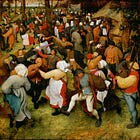Ye Olde Tools of the Trade
The tools I use to make Ye Olde Tyme News
Writing a newsletter/blog/website/whatever this is involves much more than simply sitting down, typing something into Substack, and hitting “Publish.”
While I think my toolkit is probably more rudimentary than some of the more accomplished writers/artists/creatives/scribes/whatever we are out there, I thought it might be useful to give you, the reader, a rundown of the tools I use, how I use them, how much they cost, etc. in case you were thinking of creating your own [insert whatever dirty little ideas are brewing in your dirty little mind here].
I’ve broken it down into various sections, based on the tools I use for each of these tasks:
Planning
Writing
Artwork
Research
Learning How to Write Good
So, in a slight departure from our usual fare of medieval satire, here’s the tools I use. I hope it helps in some way as you embark upon your journey to [insert whatever kind of dirty little writing journey you’re embarking upon here].
Planning
Wait, this guy put planning first? Before writing?
What an idiot. Real writers listen to the Muse, man. Real writers write based on their feelings, not based on some plan. He’s not a true artist.
That may be. But for someone with two young kids and a full time job, if I didn’t schedule time to write, it would never happen. Even as much as I try to plan it, life often gets in the way. That’s why you might see three or four posts one week, and no posts the next.
Anyway, that’s why I put planning/scheduling first. Maybe your situation is different. If so, congratulations. Let me know what you would put first, and maybe I’ll try it in 20 years if/when my kids move out.
Now on to the first tool on our list.
1 - Alarm Clock.
Cost - Free (assuming you already have a cell phone, or a watch, or a rooster)
You might call me a “morning writer.” I think my most creative time is in the first hour or so after I wake up, before my mind has been polluted by the distractions and anxieties of the day.
I find the morning to be the best time for me for creative and divergent thinking, things like brainstorming, stream of consciousness writing, and just generally writing down whatever weird stuff happens to pop into my mind.
One problem: these other annoying things called “responsibilities” tend to get in the way.
I usually try to get up around 5:30 or 6:00am. Some days I’ll get until about 6:30 or 7:00 before one of the kids gets up, so I’ll get in a solid 45 minutes to an hour of writing. Some days they’ll wake up at like 5:15 and it’s straight into a diaper change and [insert whatever heinous things the kids want to do at 6:00am here]. In the latter case I’ll try to squeeze in writing time later in the day.
2 - Turn Off ALL Notifications
Cost - This basically pays YOU
Except for, like, family and emergencies. Maybe work. But even at work you can probably get away with minimizing notifications, unless your job is super high speed or your boss sucks.
I know this isn’t really a tool. But if you can manage to turn off notifications — and avoid checking social media every five minutes — your focus will improve so much that you’ll do great no matter what tools you use.
3 - Weekly Schedule.
Cost - $2 (Or in my case, I do this in a notebook I got from work for free)
On Sundays, I like to plan out key events throughout the week. On a piece of paper I’ll draw a grid, where there’s seven columns for each day of the week, and three rows for morning, afternoon, and evening.
In each box, I’ll start by putting key events that have to be done during that time period each day. This gives me a rough idea of what time slots I’ll have available for things I want to do. I don’t put exact times when they’re not needed, because this overly constrains my schedule. I’ll also write a list of the top 3-5 priorities for the week below the schedule.
I’ve found this to be a great technique both for time management, and for gaining perspective on what is actually important. Make sure you make time for both the good stuff you want to do (writing, time with kids, exercise, etc.), as well as the bad stuff you have to do (writing, work meetings, colonoscopy, etc.).
Admittedly, I’m not as consistent with this as I’d like, and often forget to do it some weeks. But the weeks I do it I am much more productive, and happy.
4 - Daily Schedule.
Cost - Free. Use the same notebook as the weekly schedule, you idiot. Or $30 if you want to use a whiteboard.
Just like I make a weekly schedule each Sunday before the week begins, each evening I’ll make a daily checklist of key things I have to get done the following day. This is simply a checklist. I’ll work through the checklist in order of most important to least important, or easiest to hardest, or hardest to easiest, or some combination of these, depending on how I feel.
Checking things off is very satisfying. Then, once everything is checked off, I’m pretty much free to do whatever I want the rest of the day. This is when I’ll put time towards the bigger weekly priorities I identified in the weekly schedule, or do things from the weekly schedule that I want to do but aren’t necessities.
Sometimes new things will pop up that I hadn’t previously planned for. If it’s something I can’t do that day, I’ll write it on a whiteboard in my house so that it taunts me until I get it done.
Writing
Now to the second most important part of writing: writing.
1 - Notebook
Cost - $2 (Or, in my case, I use the same one I got for free from work that I use for my daily/weekly schedules)
There’s something about longhand writing that makes things click much better than typing on a keyboard. Whenever possible, I try to write by hand rather than on a computer.
I brainstorm headlines and new ideas in a notebook. Sometimes I’ll get a general idea for something I want to write about, then I’ll write 10-20 variations of it longhand until I find the one that clicks. Other times, I won’t really think about anything in particular but will just write down whatever comes to mind. Sometimes what comes out is completely nonsensical, but other times it works. I wrote this story almost entirely longhand in about an hour while sitting on my couch.
In the mornings I especially enjoy writing in a notebook, and will try to write longhand for as long as possible before ever looking at a screen. (That said, it is currently 4:42am and I am writing this on an iPad).
I also have a small pocket notebook that I sometimes bring on walks, and I’ll jot down notes as they pop into my head. Whenever possible, I try to leave my phone at home during these walks.
I think the general idea here is to get to a place where it’s just you and the writing. Digital devices open up too much opportunity for distractions. You need to make an extra mental effort not to open Instagram, and not to google the calls of various bird species of the mid-Atlantic to find out which one is currently tweeting outside your window. Even if you’re able to resist these urges, the thought is still there somewhere in the back of your mind, sucking the mental energy that should otherwise go towards creativity.
2- Pens
Cost - $20.
I use a Pilot Precise V5 RT, and I refuse to use anything else. It’s a rollerball pen with an “Extra Fine” 0.5mm tip. I write very fast, and also like to doodle and draw charts and things, so ballpoint pens don’t really work for me. I prefer the liquidy ink of a rollerball.
It’s also refillable, which is great because it goes through ink pretty quick.
3 - Word Processing Applications
Cost - Google Docs: Free. Microsoft Office 365: $70/year
Alas, at some point the writing has to transition to the digital medium. For longer stories or ones that require collaboration with another writer, I use Google Docs (as Jim Hodgson and I did for the Medieval HOA series). At work I use Microsoft Word. But for personal use, their Office 365 subscription model is, frankly, a scam. I still pay for it, but I am angry about it and refuse to use it unless I have to.
I have to say, I’m not a huge fan of Google Docs, either. But it’s pretty ubiquitous because most people have a gmail account, and it’s really easy to share things and collaborate.
For laying out longer and more complex types of things, Google Docs isn’t really up to the task. For Ye Olde Tyme Quest: The Peasant, I did the initial draft in Docs, but then formatted it in Word before finally converting it to a PDF. I’ve also used Word for various children’s books I’ve made for my daughter.
Someday I’ll try a new word processor, but I haven’t made the jump yet.
4 - Notes App
Cost - Free
I use the Notes app on my phone similar to how I use a paper notebook. If I’m somewhere where I don’t have a notebook, or it’s in the other room but I have my phone on me and am too lazy to walk there, I write things down in Notes.
Pretty much any time an idea pops into my head at any time of the day, I have to write it down or else it will gnaw at the back of my mind all day, until I finally get to a time many hours later when I can think on it further, at which point I will forget it completely. So I use Notes to get ideas out of my head and into a place where I can pull them up later so I don’t forget them.
I have a general file for random thoughts throughout the day, another for headlines I’m working on, others for writing tips and brainstorming techniques that I can use as a quick reference, and still others that I haven’t looked at in three years and refuse to open because I’m afraid of what they might contain.
Sometimes I’ll write full articles in Notes if I don’t have a notebook or computer available, although I don’t enjoy typing out a whole story with my fat thumbs on a tiny touchscreen keyboard that was built for mice.
5 - Data Visualization
Cost - Numbers app: Free; Microsoft Excel: $70/year, included in Office 365 along with Word)
I don’t know if this counts as “writing,” but I didn’t know where else to put it. Sometimes I’ll crunch numbers on Ye Olde Tyme News and make a chart.
If it’s something very basic where the data is totally made up and I just want to make a silly chart, I’ll use the Numbers iPad app. It’s really easy to make a quick visualization based on simple data, like this:
If there’s more data involved, and if it’s real, I’ll usually use Excel. Examples here:
Artwork
1 - Procreate
Cost - $13 (one-time charge)
Procreate might be my favorite iPad app. I also love that it’s a one-time charge, rather than a subscription that you have to pay for every year until you die, and probably after that, too.
Some of the images on Ye Olde Tyme News I draw myself. Typically in Procreate. This includes comics, illuminated borders, and some of the featured images of articles. If you follow the Instagram page, you’ll probably see these frequently, in images like this:
And cartoons, like this:
Or this:
The problem is, it takes a long time. I have no background in art or illustration, so I’ve been sort of learning as I go. YouTube videos have been a big help.
I haven’t had as much time to draw recently, but I hope to make comics and art in general a much bigger part of my repertoire in the future.
2- Photoshop
Cost - $21/month, or more depending on your plan)
Like with Microsoft Office, Adobe Photoshop is a ripoff. But it’s a useful ripoff. And it’s also super fun.
While I use Procreate for drawing, I use Photoshop for, well, photoshopping. A lot of times, I have an idea of what type of image I need for an article, but no public domain version of that type of image exists. Other times, the only good images that exist are low quality. If I have time, sometimes I’ll try to draw an image in Procreate. But my skillset in this regard is limited. So if I need something more complex, I’ll try to find an old piece of artwork online and edit in Photoshop to get what I need.
Usually this involves some combination of touching up low quality images from the Middle Ages, cropping and moving things around, colorizing them, and combining elements from different images together.
Example:

3 - Midjourney
Cost - $10/month
I don’t use AI-generated art on Ye Olde Tyme News that much. For one, it’s not “real” art and is taking jobs from real artists or whatever. For two, it kind of sucks.
However, it’s fun to play around with. If there’s a type of image that I really need, but is beyond my skillset to draw, and I can’t find anything close enough in the public domain, I might use Midjourney to make it. Usually, I’ll still have to do a good amount of photoshopping afterwards to get it where I need it.
I enjoy using it for personal projects. I’ve already made one children’s book for my daughter using a combination of Midjourney-generated images and Photoshop, and I plan on making more.
4 - Images from the Middle Ages
Cost - Free
A lot of this just involves googling the type of image I want, then trying to find a public domain image or something under a Creative Commons license to use. Google’s reverse image search is also very helpful, and I use it almost daily. I don’t pay for a subscription to any of the fancy photo sites, because they tend to be far beyond my budget. So making sure the image is in the public domain or under a Creative Commons license is pretty important when it comes to me not getting sued.
Fortunately, copyright expires 70 years after an artist’s death, and the Middle Ages ended significantly more than 70 years ago. You’ll still find sites that try to “copyright” artwork from the Middle Ages that they really should have no right to copyright, but for the most part it’s not too hard to find something that works.
When it comes to fantasy characters, finding the right image is a little harder. A lot of the best fantasy artwork is made by living artists, and I can’t afford to pay someone to draw things for me (yet). When I need a wizard, troll, or elf, I’ll usually draw it myself, photoshop something, use Midjourney, find something in the public domain that’s close enough, or some combination of these.
Here’s a list of a few sites with freely usable images that I refer to often:
Wikimedia Commons. Probably the most extensive collection of Creative Commons-licensed art, and the one I use most frequently.
British Library. They have a great assortment of texts and artwork from the Middle Ages. Their blog is a good read, too.
The Wellcome Collection. “A free museum and library exploring health and human experience.” Good source for public domain images.
Wiktenauer. Sort of a Wikipedia devoted to historical European martial arts texts. The fact that this site exists restores my faith in the internet.
Wikiart. A wiki specifically for artwork. Not all of the images are in the public domain, so make sure you check the license first before you use one.
J. Paul Getty Museum. Also has a bunch of public domain artwork.
Instagram. There’s various Instagram pages devoted to artwork from specific time periods, and a lot of them cite the artist or source it came from, which makes it easy to find the original.
Research
Cost - Free
While Ye Olde Tyme News makes no claims to historical accuracy – the entire thing exists in a fantasy universe, after all – I do a good bit of research to try and capture the essence of the Middle Ages when I’m writing about a particular topic.
When it comes to the longer Addenda, which are about actual history, I spend a lot of time reading and researching the topics I’m writing about. I’m not a “historian,” but I try my best to use good methods when analyzing history.
Primary and contemporary sources are the best, not necessarily for historical accuracy, but for getting into the mind of a person from that period. They’re also usually a more interesting read than an article or research paper. History is more than just a factual recounting of events in the order they occurred. It’s about what life was like; about how things looked, smelled, felt, and tasted; it’s about people and how they experienced the world.
So I like to get as close as possible to the source. Sometimes these can be hard to find. Often they’re a pdf of an old book in Latin that someone scanned and put up on a now-defunct website in 2004; or a student’s translation of a medieval text on an obscure university website with an expired SSL cert.
Here’s a few tools I use to try and find good sources:
Wikipedia. Once again, gotta start with Wikipedia. The references and external links at the bottom of the articles are what I look for. Sometimes a source I really want to read is behind a paywall. In those cases, I turn to…
The Internet Archive. If something is not online currently, there’s a good chance it was in the past. If you know what you’re looking for, you can usually find it on the Wayback Machine. This is particularly helpful for finding pdfs of old books.
Universities’ Medieval Studies Departments. Usually these will have translations of old texts, or at least links to those translations. One example is the Fordham Medieval Sourcebook.
Project Gutenberg. Also a great source for public domain books.
Medievalists.net. If there’s a topic from the Middle Ages you’re interested in, chances are they’ve written about it here. Usually they will provide citations that make it easier to find primary source documents.
The Library. Yes, the physical one. If I can’t find the right information online, and I don’t want to buy a book just to research a single article, I’ll check if my library has it. Also, my wife yells at me for buying too many books, so I’ve been going to the library more often lately.
Reddit. r/AskHistorians is always a good one. Or just do a general search of reddit. Obviously, it’s not necessarily a rigorous research methodology to blindly trust strangers on reddit, but the good ones will usually link to sources.
Learning How to Write Good
Cost - Mental and emotional stability
I make no claims to writing good well goodly. However, I do write a lot, so I have some qualifications in the matter. And I think the first key to good writing is doing a lot of it. If you write 10,000 words, there’s a decent chance you can find at least 500 good ones in there. If you write 100,000 words, there will be at least 5,000 good ones.
And so on. Maybe your ratio is better than mine.
It takes writing a lot of crap to find one thing that works. I’ve published well over 1,000 articles/short stories/essays/etc. at various publications. If only 10% of those are worth a damn, well, that’s 100 good stories. Nobody will remember the 900 shitty ones anyway.
Do I get anxiety and feel like crap when nobody reads or “likes” a story I wrote? Of course. I have at least one or two days a week where I tell myself I’m done for, I’m washed up, and I’ll never write a single thing of value ever again. But then I wake up the next morning, an idea pops into my head, and I get back to work.
Writing is a sine wave of emotional victories and defeats. At some point you just have to accept that.
Some things that have helped me write better are, from a mindset perspective:
Accept that most of what you write is going to be bad. Once you accept this fact, it frees you up to write with an open mind, without worrying about whether it’s good or not.
Have a routine. I’m a morning writer. Maybe you’re a tweaking-out-at-one-AM-on-ten-cups-of-coffee writer. Whatever it is, try to find a writing routine that works, and have the discipline to stick to it.
Be willing to break the routine. Sometimes life gets in the way of our plans. That’s okay. Recognize when you have to deviate from the routine, and either find a different time to write or take a break. Sometimes the best ideas come when you’re out of your element.
Comedy = Truth + Pain, as John Vorhaus says in The Comic Toolbox. Tell the truth. Make people laugh, then make them think. Comedy helps us laugh at the things in life that otherwise hurt. I don’t think every comic story has to drive at some deeper truth — sometimes it’s okay to just be silly — but the best ones do.
And some tactics, techniques, and procedures (TTPs) I commonly use to come up with ideas:
Free association. Try to find connections between things without really thinking about it. Say I have two things on my mind: environmental activists and dragons. One thing from the modern world, one from the ancient. I’ll let my mind wander and come up with a hundred random ways they might be connected until I end up at “Green Knights Group Calls for Ethical Slaying of Dragons.”
Start with a picture and make up a story about what’s happening in it.
The wildly inappropriate response. One of my favorite comic techniques. Take a dire attitude towards a mundane circumstance, or a mundane attitude towards a dire one. This is largely what the “Dear Dark Lord” letters are based on.
Stream of consciousness writing. Sit down and just write without thinking about it until you’ve filled up a page, or two pages, or whatever goal you’ve set for yourself. I think the whole “morning pages” thing became somewhat of a fad a few years ago. But it works, and sometimes things come out that you didn’t expect.
Run a single idea through a bunch of different iterations. Scott Dikkers calls these “funny filters.” If you have an idea that’s pretty good but you can’t quite get it right, keep trying variations of it until you find one that sticks. Mix up the format, or the word order, or look at it from a different angle. There’s times when just moving a word or two around totally changes the nature and impact of a joke.
Books and writers I turn to for inspiration:
Terry Pratchett, Kurt Vonnegut, Neal Stephenson. All of them have a dark and disturbingly satirical writing style that’s at the same time hilarious, unique, and very human. The way these guys combine sci-fi, fantasy, satire, war, death, religion, and imperfect characters to strike at something deep in the heart of the human condition, while still remaining ultimately compassionate — maybe even optimistic — about humanity, is something I can only hope to emulate.
Anne Lamott, Bird by Bird. The key lesson from this book is probably one of the most important lessons in writing. Her dad told her brother, when he was struggling at the last minute to write a school report on many species of birds, “Just take it bird by bird, buddy.” One thing at a time. Letter by letter, word by word, sentence by sentence, bird by bird. That’s the only way we can do anything.
Will and Ariel Durant, The Lessons of History. This little book gives me perspective on how small and unimportant we, as individuals, are in the grand scheme of things. Maybe that’s not very inspiring. But there’s something about thinking about our own insignificance that’s freeing.
Richard Adams, Watership Down. Like Lord of the Rings if all of the main characters were bunnies. The exploration of rabbit lore and culture is amazing, and I really enjoy the story within a story device that is used throughout, where the rabbits sit around in their burrows telling each other stories about the legendary rabbit hero El-ahrairah. Storytelling is a huge part of rabbit culture, after all.
Ancient Greek texts. Thucydides, Herodotus, and Homer are good ones. As some of the oldest writing in existence, it’s fascinating to see the ways in which people and society were different from today. But it’s even more fascinating to see the ways in which they were exactly the same. Robert B. Strassler’s The Landmark series is amazing. Next on my list is The Landmark version of Xenophon’s Anabasis.
In Closing
So that’s it. Those are the main tools I use to make Ye Olde Tyme News.
Wow, that was long.
If you’ve read this far, thank you. And thank you for being a paid subscriber. I hope you got some value out of it, or at least something to complain to your [insert person/pet/imaginary friend to whom you complain about things you hate] about how you wasted so much time reading it.
What tools have you found helpful in your writing journey?
Is there anything I don’t use that I should try?
Is any of this worth it?









Well, hell. You've disrobed the ancient skill of writing of its mystery. In one fell swoop, you've told us how easy it is to write. Either intentionally or not, you've removed the challenge. Now, any Tom, Dick, or Harry can get rich by simply following your 1-2-3 formula for penning brilliant tales of yore. Nuts! You've left me no choice but to return to my previous metier of arm wrestling for money in Las Vegas.
I believe it was Wordsworth who said, "Refer thee often to a dragon dick."